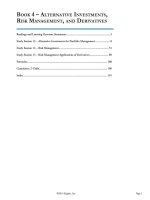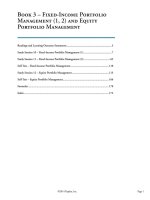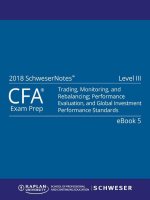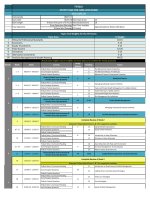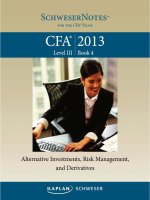Tài liệu 2018 CFA level 3 study note book5
Bạn đang xem bản rút gọn của tài liệu. Xem và tải ngay bản đầy đủ của tài liệu tại đây (6.69 MB, 260 trang )
Table of Contents
1.
2.
3.
4.
Getting Started Flyer
Table of Contents
Page List
Book 5: Trading, Monitoring, And Rebalancing; Performance Evaluation, And
Global Investment Performance Standards
5. Execution of Portfolio Decisions
1. LOS 31.a: Compare market orders with limit orders, including the price and
execution uncertainty of each.
2. LOS 31.b: Calculate and interpret the effective spread of a market order
and contrast it to the quoted bid–ask spread as a measure of trading cost.
3. LOS 31.c: Compare alternative market structures and their relative
advantages.
4. LOS 31.d: Explain the criteria of market quality and evaluate the quality of a
market when given a description of its characteristics.
5. LOS 31.e: Explain the components of execution costs, including explicit and
implicit costs, and evaluate a trade in terms of these costs.
6. LOS 31.f: Calculate and discuss implementation shortfall as a measure of
transaction costs.
7. LOS 31.g: Contrast volume weighted average price (VWAP) and
implementation shortfall as measures of transaction costs.
8. LOS 31.h: Explain the use of econometric methods in pretrade analysis to
estimate implicit transaction costs.
9. LOS 31.i: Discuss the major types of traders, based on their motivation to
trade, time versus price preferences, and preferred order types.
10. LOS 31.j: Describe the suitable uses of major trading tactics, evaluate their
relative costs, advantages, and weaknesses, and recommend a trading
tactic when given a description of the investor’s motivation to trade, the
size of the trade, and key market characteristics.
11. LOS 31.k: Explain the motivation for algorithmic trading and discuss the
basic classes of algorithmic trading strategies.
12. LOS 31.l: Discuss the factors that typically determine the selection of a
specific algorithmic trading strategy, including order size, average daily
trading volume, bid–ask spread, and the urgency of the order.
13. LOS 31.m: Explain the meaning and criteria of best execution.
14. LOS 31.n: Evaluate a firm’s investment and trading procedures, including
processes, disclosures, and record keeping, with respect to best execution.
15. LOS 31.o: Discuss the role of ethics in trading.
16. Key Concepts
1. LOS 31.a
2. LOS 31.b
3. LOS 31.c
4. LOS 31.d
5. LOS 31.e
6. LOS 31.f
7. LOS 31.g
8. LOS 31.h
9. LOS 31.i
10. LOS 31.j
11. LOS 31.k
12. LOS 31.l
13. LOS 31.m
14. LOS 31.n
15. LOS 31.o
17. Concept Checkers
1. Answers – Concept Checkers
6. Monitoring and Rebalancing
1. LOS 32.a: Discuss a fiduciary’s responsibilities in monitoring an investment
portfolio.
2. LOS 32.b: Discuss the monitoring of investor circumstances,
market/economic conditions, and portfolio holdings and explain the effects
that changes in each of these areas can have on the investor’s portfolio.
3. LOS 32.c: Recommend and justify revisions to an investor’s investment
policy statement and strategic asset allocation, given a change in investor
circumstances.
4. LOS 32.d: Discuss the benefits and costs of rebalancing a portfolio to the
investor’s strategic asset allocation.
5. LOS 32.e: Contrast calendar rebalancing to percentage-of-portfolio
rebalancing.
6. LOS 32.f: Discuss the key determinants of the optimal corridor width of an
asset class in a percentage-of-portfolio rebalancing program.
7. LOS 32.g: Compare the benefits of rebalancing an asset class to its target
portfolio weight versus rebalancing the asset class to stay within its
allowed range.
8. LOS 32.h: Explain the performance consequences in up, down, and flat
markets of 1) rebalancing to a constant mix of equities and bills, 2) buying
and holding equities, and 3) constant proportion portfolio insurance (CPPI).
9. LOS 32.i: Distinguish among linear, concave, and convex rebalancing
strategies.
10. LOS 32.j: Judge the appropriateness of constant mix, buy-and-hold, and
CPPI rebalancing strategies when given an investor’s risk tolerance and
asset return expectations.
11. Key Concepts
1. LOS 32.a
2. LOS 32.b
3. LOS 32.c
4. LOS 32.d
5. LOS 32.e
6. LOS 32.f
7. LOS 32.g
8. LOS 32.h
9. LOS 32.i
10. LOS 32.j
12. Concept Checkers
1. Answers – Concept Checkers
7. Self-Test: Trading, Monitoring, and Rebalancing
8. Evaluating Portfolio Performance
1. LOS 33.a: Demonstrate the importance of performance evaluation from the
perspective of fund sponsors and the perspective of investment managers.
2. LOS 33.b: Explain the following components of portfolio evaluation:
performance measurement, performance attribution, and performance
appraisal.
3. LOS 33.c: Calculate, interpret, and contrast time-weighted and moneyweighted rates of return and discuss how each is affected by cash
contributions and withdrawals.
4. LOS 33.d: Identify and explain potential data quality issues as they relate to
calculating rates of return.
5. LOS 33.e: Demonstrate the decomposition of portfolio returns into
components attributable to the market, to style, and to active
management.
6. LOS 33.f: Discuss the properties of a valid performance benchmark and
explain advantages and disadvantages of alternative types of benchmarks.
7. LOS 33.g: Explain the steps involved in constructing a custom securitybased benchmark.
8. LOS 33.h: Discuss the validity of using manager universes as benchmarks.
9. LOS 33.i: Evaluate benchmark quality by applying tests of quality to a
variety of possible benchmarks.
10. LOS 33.j: Discuss issues that arise when assigning benchmarks to hedge
funds.
11. LOS 33.k: Distinguish between macro and micro performance attribution
and discuss the inputs typically required for each.
12. LOS 33.l: Demonstrate and contrast the use of macro and micro
performance attribution methodologies to identify the sources of
investment performance.
13. LOS 33.m: Discuss the use of fundamental factor models in micro
performance attribution.
14. LOS 33.n: Evaluate the effects of the external interest rate environment
and active management on fixed-income portfolio returns.
15. LOS 33.o: Explain the management factors that contribute to a fixed-
income portfolio’s total return and interpret the results of a fixed-income
performance attribution analysis.
16. LOS 33.p: Calculate, interpret, and contrast alternative risk-adjusted
performance measures, including (in their ex post forms) alpha,
information ratio, Treynor measure, Sharpe ratio, and M2.
17. LOS 33.q: Explain how a portfolio’s alpha and beta are incorporated into
the information ratio, Treynor measure, and Sharpe ratio.
18. LOS 33.r: Demonstrate the use of performance quality control charts in
performance appraisal.
19. LOS 33.s: Discuss the issues involved in manager continuation policy
decisions, including the costs of hiring and firing investment managers.
20. LOS 33.t: Contrast Type I and Type II errors in manager continuation
decisions.
21. Key Concepts
1. LOS 33.a
2. LOS 33.b
3. LOS 33.c
4. LOS 33.d
5. LOS 33.e
6. LOS 33.f
7. LOS 33.g
8. LOS 33.h
9. LOS 33.i
10. LOS 33.j
11. LOS 33.k
12. LOS 33.l
13. LOS 33.m
14. LOS 33.n
15. LOS 33.o
16. LOS 33.p
17. LOS 33.q
18. LOS 33.r
19. LOS 33.s
20. LOS 33.t
22. Concept Checkers
1. Answers – Concept Checkers
9. Self-Test: Performance Evaluation
10. Overview of the Global Investment Performance Standards
1. LOS 34.a : Discuss the objectives, key characteristics, and scope of the GIPS
standards and their benefits to prospective clients and investment
managers.
2. LOS 34.b: Explain the fundamentals of compliance with the GIPS standards,
including the definition of the firm and the firm’s definition of discretion.
3. LOS 34.c: Explain the requirements and recommendations of the GIPS
4.
5.
6.
7.
8.
9.
10.
11.
12.
13.
14.
15.
16.
17.
18.
standards with respect to input data, including accounting policies related
to valuation and performance measurement.
LOS 34.d: Discuss the requirements of the GIPS standards with respect to
return calculation methodologies, including the treatment of external cash
flows, cash and cash equivalents, and expenses and fees.
LOS 34.e: Explain the requirements and recommendations of the GIPS
standards with respect to composite return calculations, including methods
for asset-weighting portfolio returns.
LOS 34.f: Explain the meaning of “discretionary” in the context of
composite construction and, given a description of the relevant facts,
determine whether a portfolio is likely to be considered discretionary.
LOS 34.g: Explain the role of investment mandates, objectives, or strategies
in the construction of composites.
LOS 34.h: Explain the requirements and recommendations of the GIPS
standards with respect to composite construction, including switching
portfolios among composites, the timing of the inclusion of new portfolios
in composites, and the timing of the exclusion of terminated portfolios
from composites.
LOS 34.i: Explain the requirements of the GIPS standards for asset class
segments carved out of multi-class portfolios.
LOS 34.j: Explain the requirements and recommendations of the GIPS
standards with respect to disclosure, including fees, the use of leverage and
derivatives, conformity with laws and regulations that conflict with the
GIPS standards, and noncompliant performance periods.
LOS 34.k: Explain the requirements and recommendations of the GIPS
standards with respect to presentation and reporting, including the
required timeframe of compliant performance periods, annual returns,
composite assets, and benchmarks.
LOS 34.l: Explain the conditions under which the performance of a past firm
or affiliation must be linked to or used to represent the historical
performance of a new or acquiring firm.
LOS 34.m: Evaluate the relative merits of high/low, range, interquartile
range, and equal-weighted or asset-weighted standard deviation as
measures of the internal dispersion of portfolio returns within a composite
for annual periods.
LOS 34.n: Identify the types of investments that are subject to the GIPS
standards for real estate and private equity.
LOS 34.o: Explain the provisions of the GIPS standards for real estate and
private equity.
LOS 34.p: Explain the provisions of the GIPS standards for Wrap
fee/Separately Managed Accounts.
LOS 34.q: Explain the requirements and recommended valuation hierarchy
of the GIPS Valuation Principles.
LOS 34.r: Determine whether advertisements comply with the GIPS
Advertising Guidelines.
19. LOS 34.s: Discuss the purpose, scope, and process of verification.
20. LOS 34.t: Discuss challenges related to the calculation of after-tax returns.
21. LOS 34.u: Identify and explain errors and omissions in given performance
presentations and recommend changes that would bring them into
compliance with GIPS standards
22. Key Concepts
1. LOS 34.a
2. LOS 34.b
3. LOS 34.c
4. LOS 34.d
5. LOS 34.e
6. LOS 34.f
7. LOS 34.g
8. LOS 34.h
9. LOS 34.i
10. LOS 34.j
11. LOS 34.k; LOS 34.l; LOS 34.m
12. LOS 34.n
13. LOS 34.o
14. LOS 34.p
15. LOS 34.q
16. LOS 34.r
17. LOS 34.s
18. LOS 34.t
19. LOS 34.u
23. Concept Checkers
1. Answers – Concept Checkers
11. Self-Test: Global Investment Performance Standards
12. Formulas
13. Copyright
Page List
1.
2.
3.
4.
5.
6.
7.
8.
9.
10.
11.
12.
13.
14.
15.
16.
17.
18.
19.
20.
21.
22.
23.
24.
25.
26.
27.
28.
29.
30.
31.
32.
33.
34.
35.
36.
37.
38.
i
iii
iv
v
vi
vii
viii
ix
1
2
3
4
5
6
7
8
9
10
11
12
13
14
15
16
17
18
19
20
21
22
23
24
25
26
27
28
29
30
39.
40.
41.
42.
43.
44.
45.
46.
47.
48.
49.
50.
51.
52.
53.
54.
55.
56.
57.
58.
59.
60.
61.
62.
63.
64.
65.
66.
67.
68.
69.
70.
71.
72.
73.
74.
75.
76.
77.
78.
79.
80.
81.
82.
31
32
33
34
35
36
37
38
39
40
41
42
43
44
45
46
47
48
49
50
51
52
53
54
55
56
57
58
59
60
61
62
63
64
65
66
67
68
69
70
71
72
73
74
83.
84.
85.
86.
87.
88.
89.
90.
91.
92.
93.
94.
95.
96.
97.
98.
99.
100.
101.
102.
103.
104.
105.
106.
107.
108.
109.
110.
111.
112.
113.
114.
115.
116.
117.
118.
119.
120.
121.
122.
123.
124.
125.
126.
75
76
77
78
79
80
81
82
83
84
85
86
87
88
89
90
91
92
93
94
95
96
97
98
99
100
101
102
103
104
105
106
107
108
109
110
111
112
113
114
115
116
117
118
127.
128.
129.
130.
131.
132.
133.
134.
135.
136.
137.
138.
139.
140.
141.
142.
143.
144.
145.
146.
147.
148.
149.
150.
151.
152.
153.
154.
155.
156.
157.
158.
159.
160.
161.
162.
163.
164.
165.
166.
167.
168.
169.
170.
119
120
121
122
123
124
125
126
127
128
129
130
131
132
133
134
135
136
137
138
139
140
141
142
143
144
145
146
147
148
149
150
151
152
153
154
155
156
157
158
159
160
161
162
171.
172.
173.
174.
175.
176.
177.
178.
179.
180.
181.
182.
183.
184.
185.
186.
187.
188.
189.
190.
191.
192.
193.
194.
195.
196.
197.
198.
199.
200.
201.
202.
203.
204.
205.
206.
207.
208.
209.
210.
211.
212.
213.
163
164
165
166
167
168
169
170
171
172
173
174
175
176
177
178
179
180
181
182
183
184
185
186
187
188
189
190
191
192
193
194
195
196
197
198
199
200
201
202
203
204
205
BOOK 5 – TRADING, MONITORING, AND
REBALANCING; PERFORMANCE EVALUATION, AND
GLOBAL INVESTMENT PERFORMANCE STANDARDS
Readings and Learning Outcome Statements
Study Session 16 – Trading, Monitoring, and Rebalancing
Study Session 17 – Performance Evaluation
Study Session 18 – Global Investment Performance Standards
Formulas
X VY
READINGS AND LEARNING OUTCOME STATEMENTS
READINGS
The following material is a review of the Trading, Monitoring, and Rebalancing;
Evaluation and Attribution; and Global Investment Performance Standards (GIPS®)
principles designed to address the learning outcome statements set forth by CFA
Institute.
STUDY SESSION 16
Reading Assignments
Trading, Monitoring, and Rebalancing, CFA Program 2018 Curriculum, Volume 6,
Level III
31. Execution of Portfolio Decisions
32. Monitoring and Rebalancing
STUDY SESSION 17
Reading Assignments
Performance Evaluation, CFA Program 2018 Curriculum, Volume 6, Level III
33. Evaluating Portfolio Performance
STUDY SESSION 18
Reading Assignments
Global Investment Performance Standards, CFA Program 2018 Curriculum, Volume
6, Level III
34. Overview of the Global Investment Performance Standards
LEARNING OUTCOME STATEMENTS (LOS)
The CFA Institute learning outcome statements are listed in the following. These are
repeated in each topic review. However, the order may have been changed in order
X VY
to get a better fit with the flow of the review.
STUDY SESSION 16
The topical coverage corresponds with the following CFA Institute assigned
reading:
31. Execution of Portfolio Decisions
The candidate should be able to:
a. compare market orders with limit orders, including the price and execution
uncertainty of each. (page 1)
b. calculate and interpret the effective spread of a market order and contrast it
to the quoted bid–ask spread as a measure of trading cost. (page 2)
c. compare alternative market structures and their relative advantages.
(page 5)
d. explain the criteria of market quality and evaluate the quality of a market
when given a description of its characteristics. (page 7)
e. explain the components of execution costs, including explicit and implicit
costs, and evaluate a trade in terms of these costs. (page 8)
f. calculate and discuss implementation shortfall as a measure of transaction
costs. (page 9)
g. contrast volume weighted average price (VWAP) and implementation
shortfall as measures of transaction costs. (page 13)
h. explain the use of econometric methods in pretrade analysis to estimate
implicit transaction costs. (page 14)
i. discuss the major types of traders, based on their motivation to trade, time
versus price preferences, and preferred order types. (page 14)
j. describe the suitable uses of major trading tactics, evaluate their relative
costs, advantages, and weaknesses, and recommend a trading tactic when
given a description of the investor’s motivation to trade, the size of the
trade, and key market characteristics. (page 15)
k. explain the motivation for algorithmic trading and discuss the basic classes of
algorithmic trading strategies. (page 17)
l. discuss the factors that typically determine the selection of a specific
algorithmic trading strategy, including order size, average daily trading
volume, bid–ask spread, and the urgency of the order. (page 18)
m. explain the meaning and criteria of best execution. (page 20)
n. evaluate a firm’s investment and trading procedures, including processes,
disclosures, and record keeping, with respect to best execution. (page 20)
o. discuss the role of ethics in trading. (page 21)
The topical coverage corresponds with the following CFA Institute assigned
reading:
32. Monitoring and Rebalancing
The candidate should be able to:
a. discuss a fiduciary’s responsibilities in monitoring an investment portfolio.
(page 34)
b. discuss the monitoring of investor circumstances, market/economic
conditions, and portfolio holdings and explain the effects that changes in
each of these areas can have on the investor’s portfolio. (page 34)
c. recommend and justify revisions to an investor’s investment policy
statement and strategic asset allocation, given a change in investor
circumstances. (page 35)
d. discuss the benefits and costs of rebalancing a portfolio to the investor’s
strategic asset allocation. (page 35)
e. contrast calendar rebalancing to percentage-of-portfolio rebalancing.
(page 36)
f. discuss the key determinants of the optimal corridor width of an asset class
in a percentage-of-portfolio rebalancing program. (page 37)
g. compare the benefits of rebalancing an asset class to its target portfolio
weight versus rebalancing the asset class to stay within its allowed range.
(page 38)
h. explain the performance consequences in up, down, and flat markets of 1)
rebalancing to a constant mix of equities and bills, 2) buying and holding
equities, and 3) constant proportion portfolio insurance (CPPI). (page 38)
i. distinguish among linear, concave, and convex rebalancing strategies.
(page 41)
j. judge the appropriateness of constant mix, buy-and-hold, and CPPI
rebalancing strategies when given an investor’s risk tolerance and asset
return expectations. (page 42)
STUDY SESSION 17
The topical coverage corresponds with the following CFA Institute assigned
reading:
33. Evaluating Portfolio Performance
The candidate should be able to:
a. demonstrate the importance of performance evaluation from the
perspective of fund sponsors and the perspective of investment managers.
(page 59)
b. explain the following components of portfolio evaluation: performance
measurement, performance attribution, and performance appraisal.
(page 60)
c. calculate, interpret, and contrast time-weighted and money-weighted rates
of return and discuss how each is affected by cash contributions and
withdrawals. (page 62)
d. identify and explain potential data quality issues as they relate to calculating
rates of return. (page 66)
e. demonstrate the decomposition of portfolio returns into components
attributable to the market, to style, and to active management. (page 66)
f. discuss the properties of a valid performance benchmark and explain
advantages and disadvantages of alternative types of benchmarks. (page 67)
g. explain the steps involved in constructing a custom security-based
benchmark. (page 70)
h. discuss the validity of using manager universes as benchmarks. (page 71)
i. evaluate benchmark quality by applying tests of quality to a variety of
possible benchmarks. (page 71)
j. discuss issues that arise when assigning benchmarks to hedge funds.
(page 73)
k. distinguish between macro and micro performance attribution and discuss
the inputs typically required for each. (page 74)
l. demonstrate and contrast the use of macro and micro performance
attribution methodologies to identify the sources of investment
performance. (page 74)
m. discuss the use of fundamental factor models in micro performance
attribution. (page 82)
n. evaluate the effects of the external interest rate environment and active
management on fixed-income portfolio returns. (page 84)
o. explain the management factors that contribute to a fixed-income
portfolio’s total return and interpret the results of a fixed-income
performance attribution analysis. (page 84)
p. calculate, interpret, and contrast alternative risk-adjusted performance
measures, including (in their ex post forms) alpha, information ratio, Treynor
measure, Sharpe ratio, and M2. (page 87)
q. explain how a portfolio’s alpha and beta are incorporated into the
information ratio, Treynor measure, and Sharpe ratio. (page 92)
r. demonstrate the use of performance quality control charts in performance
appraisal. (page 93)
s. discuss the issues involved in manager continuation policy decisions,
including the costs of hiring and firing investment managers. (page 94)
t. contrast Type I and Type II errors in manager continuation decisions.
(page 95)
STUDY SESSION 18
The topical coverage corresponds with the following CFA Institute assigned
reading:
34. Overview of the Global Investment Performance Standards
The candidate should be able to:
